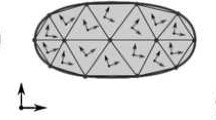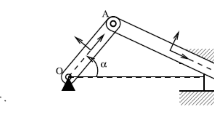Abstract
This paper deals with the dynamic description of interconnected rigid and flexible bodies. The absolute nodal coordinate formulation is used to describe the motion of flexible bodies and natural coordinates are used to describe the motion of the rigid bodies. The absolute nodal coordinate formulation is a nonincremental finite element procedure, especially suitable for the dynamic analysis of flexible bodies exhibiting rigid body motion and large deformations. Nodal coordinates, which include global position vectors and global slopes, are all defined in a global inertial coordinate system.
The advantages of using the absolute nodal coordinate formulation include constancy in the mass matrix and the need for only a minimal set of nonlinear constraint equations when connecting different flexible bodies with kinematic joints. When bodies within the system can be considered rigid, the above-mentioned advantages of the equations of motion can be preserved, provided natural coordinates are used. In the natural coordinate method, the coordinates used to describe rigid bodies include global position vectors of basic points and global unit vectors. As occurs in absolute nodal coordinate formulation, rotational coordinates are avoided and the mass matrix is also constant. This paper provides computer implementation of this formulation that uses absolute coordinates for general two-dimensional multibody systems.
The constraint equations needed to define kinematic joints between different bodies can be linear or nonlinear. The linear constraint equations, which include those needed to define rigid connections and revolute joints, are used to define constant connectivity matrices that reduce the size of the system coordinates. These constant connectivity matrices are also used to obtain the mass matrix and generalized forces of the system. However, the nonlinear constraint equations that account for sliding joints require the use of the Lagrange multipliers technique. Numerical examples are provided and compared to the results of other existing formulations.
Similar content being viewed by others
References
Omar, M. A. and Shabana, A. A., ‘A two-dimensional shear deformation beam for large rotation and deformation’, Journal of Sound and Vibration 243(3), 2001, 565–576.
Shabana, A. A. and Yakoub, R. Y., ‘Three dimensional absolute nodal coordinate formulation for beam elements: Theory’, ASME Journal of Mechanical Design 123, 2001, 606–613.
Yakoub, R. Y. and Shabana, A. A., ‘Three dimensional absolute nodal coordinate formulation for beam elements: Implementation and application’, ASME Journal of Mechanical Design 123, 2001, 614–621.
Escalona, J. L., Hussein, A. H., and Shabana A. A., ‘Application of the absolute nodal coordinate formulation to multibody system dynamics’, Journal of Sound and Vibration 214, 1998, 833–851.
Sugiyama, H., Escalona, J. L., and Shabana, A. A., ‘Formulation of three-dimensional joint constraints using the absolute nodal coordinates’, Nonlinear Dynamics, 2003, in press.
Shabana, A. A., Dynamics of Multibody Systems, Wiley, New York, 1998.
Wu, S. and Haug, E. J., ‘Geometric nonlinear substructuring for dynamics of flexible mechanical systems’, International Journal for Numerical Methods in Engineering 26, 1988, 2211–2226.
Mayo J., Dominguez, J., and Shabana, A. A., ‘Geometrically nonlinear formulations of beams in flexible multibody dynamics’, ASME Journal of Vibration and Acoustics 117, 1995, 501–559.
Bathe, K. J., Finite Element Procedures, Prentice Hall, Englewood Cliffs, NJ, 1996.
Simo, J. C., Tarnow, N., and Doblaré, M., ‘Non-linear dynamics of three-dimensional rods: Exact energy and momentum conserving algorithms’, International Journal for Numerical Methods in Engineering 38, 1995, 1431–1473.
Romero, I., ‘Formulation and analysis of dissipative algorithms for nonlinear elastodynamics’, Ph.D. Thesis, University of California, Berkeley, CA, 2001.
Simo, J. C., ‘A finite strain beam formulation. The three-dimensional dynamic problem. Part I’, Computer Methods in Applied Mechanics and Engineering 49, 1985, 55–70.
Simo, J. C. and Vu-Quoc, L., ‘A three-dimensional finite-strain rod model. Part II’, Computer Methods in Applied Mechanics and Engineering 58, 1986, 79–116.
García de Jalón, J. and Bayo, E., Kinematic and Dynamic Simulation of Multibody Systems – The Real-Time Challenge, Springer, New York, 1993.
Avello, A., ‘Dinámica de mecanismos flexibles con coordenadas cartesianas y teoría de grandes deformaciones’, Ph.D. Thesis, University of Navarre, San Sebastián, 1990.
García-Vallejo, D., Escalona, J.L., Mayo, J., and Domínguez, J., ‘Describing rigid-flexible multibody systems using natural and absolute nodal coordinates’, in Proceedings of DETC'03, ASME Design Engineering Technical Conferences and Computers and Information in Engineering Conference, Chicago, IL, September 2–6, ASME, New York, 2001.
Shabana, A. A. and Mikkola, A. M., ‘Modelling slope discontinuity using the absolute coordinate formulation’, Technical Report MBS01-5-UIC, The University of Illinois at Chicago, IL, 2001.
Mikkola, A. M. and Shabana, A. A., ‘A new plate element based on the absolute nodal coordinate formulation’, in Proceedings of DETC'01, ASME Design Engineering Technical Conferences and Computers and Information in Engineering Conference, Pittsburgh, PA, September 9–12, ASME, New York, 2001.
Author information
Authors and Affiliations
Rights and permissions
About this article
Cite this article
García-Vallejo, D., Escalona, J.L., Mayo, J. et al. Describing Rigid-Flexible Multibody Systems Using Absolute Coordinates. Nonlinear Dynamics 34, 75–94 (2003). https://doi.org/10.1023/B:NODY.0000014553.98731.8d
Issue Date:
DOI: https://doi.org/10.1023/B:NODY.0000014553.98731.8d




